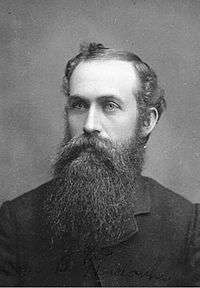John Fairbanks

(Date unknown, 1890s?)
John B. Fairbanks (December 25, 1855, Payson, Utah – June 15, 1940, Salt Lake City) was an American landscape painter. In 1890, he was one of a group of artists who studied in Paris under the sponsorship of The Church of Jesus Christ of Latter-day Saints (LDS Church), in preparation for painting murals at the nearly completed Salt Lake Temple.
Biography
His father, also named John Boylston Fairbanks (1817-1875), was an early pioneer who had come to Utah from the Winter Quarters in 1847.[1] Although he showed an early interest in art, he had no inclination to pursue it as a career until, in 1877, he visited the studios of John Hafen, an aspiring artist his own age. After a long time of spending most of his days at the studio, Hafen dared him to do a painting.[2] He did, it was good (he had a hard time convincing his mother that it was his), and that was the beginning of his career. Hafen became his lifelong friend and mentor.[3]

He married that same year,[4] but his paintings were not successful, so he found it necessary to take other work, which ranged from assisting the photographer George Edward Anderson to selling newspapers.[3] He was called to be a missionary in the Southern States Mission of the Church from 1881 to 1883.[4] Upon returning, he took a job in his father-in-law's store, painting furniture.[2]
In 1890, together with Hafen, Edwin Evans and Lorus Pratt, he was awarded a two-year scholarship to study at the Académie Julian in Paris, where their primary instructor was Albert Rigolot, and they became known as the "French Art Missionaries". Upon their return, they executed the murals and frescoes for the Salt Lake Temple, which was consecrated in 1893. Years later, he also helped to decorate the Church Administration Building and the Mesa Arizona Temple.[4]
Later career

He was able to secure a position teaching at the "Brigham Young Academy" (now BYU), but he still received little public recognition. Then, in 1898, his wife Lillie died from a fall downstairs.[3] She had been carrying their baby son and may have sacrificed herself to save him. The boy, Avard, suffered no serious injuries and grew up to be a well-known sculptor. Struggling to support his seven children, he accepted an offer of employment from Benjamin Cluff to make sketches and photographs on his archaeological expedition to Latin America.[3] While returning, he passed through New York and would later spend much time there, copying works to sell back home. In 1917, while painting in Zion National Park, he met his second wife, Florence Giffords, who was almost forty years his junior, and eventually had five more children.[2]
His art was never financially successful and he occasionally supplemented his income by working as a window dresser.[3] He also served as an art supervisor for the public schools of Ogden, Utah,[4] and as a board member of the Utah Art Institute (now the Utah Division of Arts and Museums).[3] Although he painted until the very last days of his life, he never achieved wide recognition.
References
- ↑ Fairbanks Family in the West
- 1 2 3 "John Boylston Fairbanks" by Brian Warburton from the Harold B. Lee Library @ BYU.
- 1 2 3 4 5 6 Brief biography @ the Springville Museum of Art, with additional paintings.
- 1 2 3 4 Biographical sketch @ MormonWiki.
Further reading
- Robert Olpin, Thomas Rugh; Painters of the Wasatch Mountains, Salt Lake City, Gibbs Smith, Publisher, 2005 ISBN 1-58685-850-5
- Robert Olpin, Donna Poulton, Vern Swanson; Utah art, Utah artists : 150 year survey, Layton, Gibbs Smith, 2001 ISBN 1-58685-111-X
- Florence, Giles H., Jr., "Harvesting the Light: The 1890 Paris Art Mission", Ensign
External links
| Wikimedia Commons has media related to John Fairbanks. |
- Portrait of his mother @ FamilySearch
- NWDA: Inventory of the John B. Fairbanks papers.
- John B. Fairbanks's diary from at L. Tom Perry Special Collections, Brigham Young University